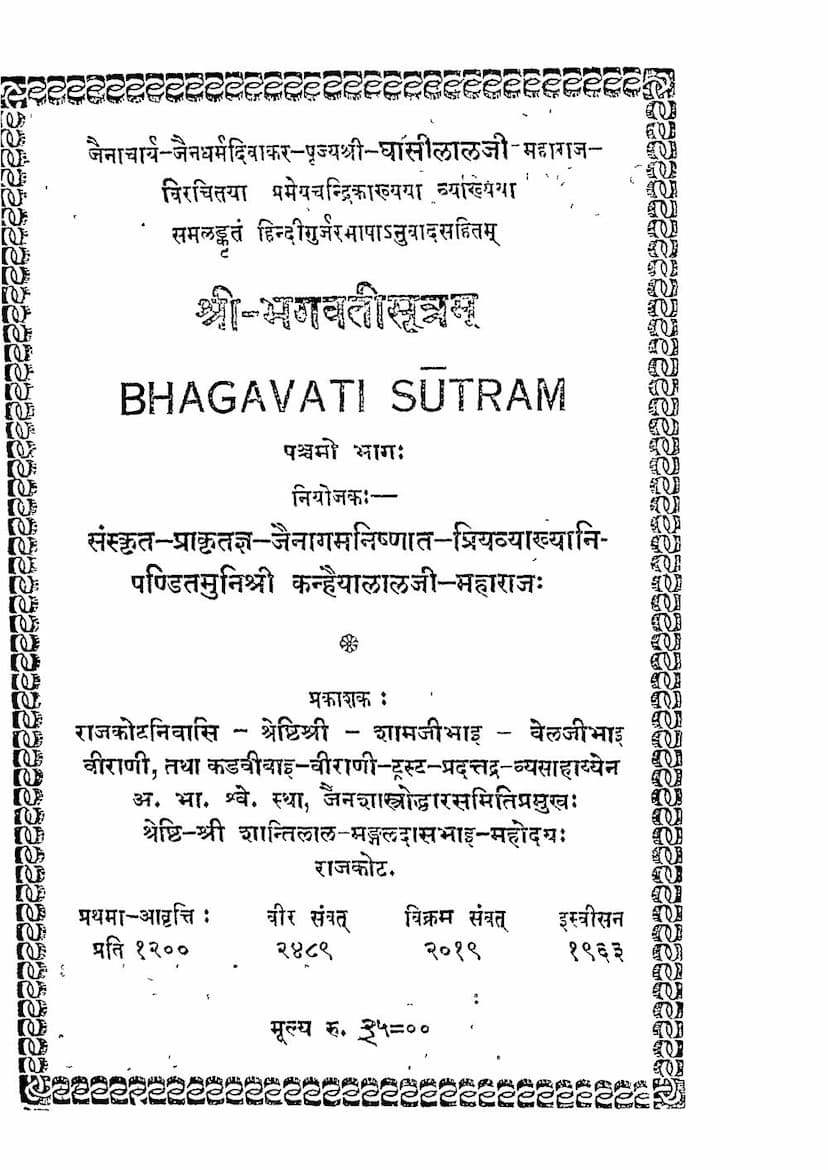Bhagwati Sutra Part 05
Added to library: September 1, 2025

Summary
The Bhagwati Sutra, Part 05, authored by Ghasilal Maharaj and published by A B Shwetambar Sthanakwasi Jain Shastroddhar Samiti, is a significant text within Jainism. This particular volume, the fifth part of the Bhagwati Sutra, is enriched by the commentary 'Prameyachandrika' by Acharya Ghasilalji Maharaj and includes a Hindi-Gujarati translation. The catalog link provided is https://jainqq.org/explore/009315/1.
The text is structured into chapters (Shatak) and sections within those chapters (Uddesh). Based on the provided index (pages 3-6), this volume of the Bhagwati Sutra covers the following:
Sixth Shatak (Sixth Century):
- Sixth Uddesh: Describes the nature of the Seven Earths (Prithvi) and discusses the Marananthika Samudghata (a specific type of spiritual exertion at the end of life).
- Seventh Uddesh: Touches upon the continuity of life force in organisms, the measurement of time, and the characteristics of Bharatkshetra during the Susham-Sushma period.
- Eighth Uddesh: Deals with various aspects of life, including the nature of the earth, the process of life-span binding, the characteristics of the Salt Sea (Lavan Samudra), different types of karma, and the powers and knowledge of celestial beings.
- Ninth Uddesh: Discusses the concept of singular experience of suffering, the diet of beings in lower realms (Nairayika), the incorporeal nature of Kevalins (omniscient beings), and the characteristics of beings in different life states.
- Tenth Uddesh: Explores the views of other religious sects on knowledge and self, the nature of souls, and the process of life-span binding.
Seventh Shatak (Seventh Century):
- First Uddesh: Begins by detailing the subject matter of the seventh century, including descriptions of various grains and their seed viability, time measurement, the nature of the universe, the conduct of monks and lay followers, the destination of liberated souls, and dietary practices.
- Second Uddesh: Focuses on the nature of lives, the concept of origination, the characteristics of sentient and non-sentient beings, and the consequences of actions, including karma and its effects. It also touches upon the practices of renunciates and the nature of vows.
- Third Uddesh: Delves into the nature of beings, including the concept of soul transmigration, the causes of rebirth, and the karmic consequences that lead to different life forms. It also discusses the concept of suffering and its alleviation through spiritual practices.
- Fourth Uddesh: Describes the nature of beings, including the concept of karma, its bondage and fruition, and the path to liberation. It further explores the characteristics of different types of beings and their karmic dispositions.
The initial pages (1-2) of the text provide publication details, including the publisher, printer, and year of publication (Veer Samvat 2489, Vikram Samvat 2019, corresponding to 1963 AD). The introduction also highlights the importance of knowledge in Jainism and mentions the societal upliftment work of the Akhil Bharat Shwetambar Sthanakwasi Jain Shastroddhar Samiti. Pages 8-15 offer a glimpse into the life of Shri Vinod Muni, detailing his journey from a businessman to renunciation and his initiation into asceticism, including his tragic demise. Pages 25-27 provide details about the committee's ongoing efforts to publish Jain scriptures and appeal for financial support.
The core of the summary lies in the detailed breakdown of the Shataks and Uddesh's, which cover a wide range of Jain philosophical and ethical concepts, including cosmology, karma theory, the nature of the soul, the path to liberation, and the conduct of monks and lay followers. The text aims to explain complex Jain principles in a clear and accessible manner, as evidenced by the commentary and translations.